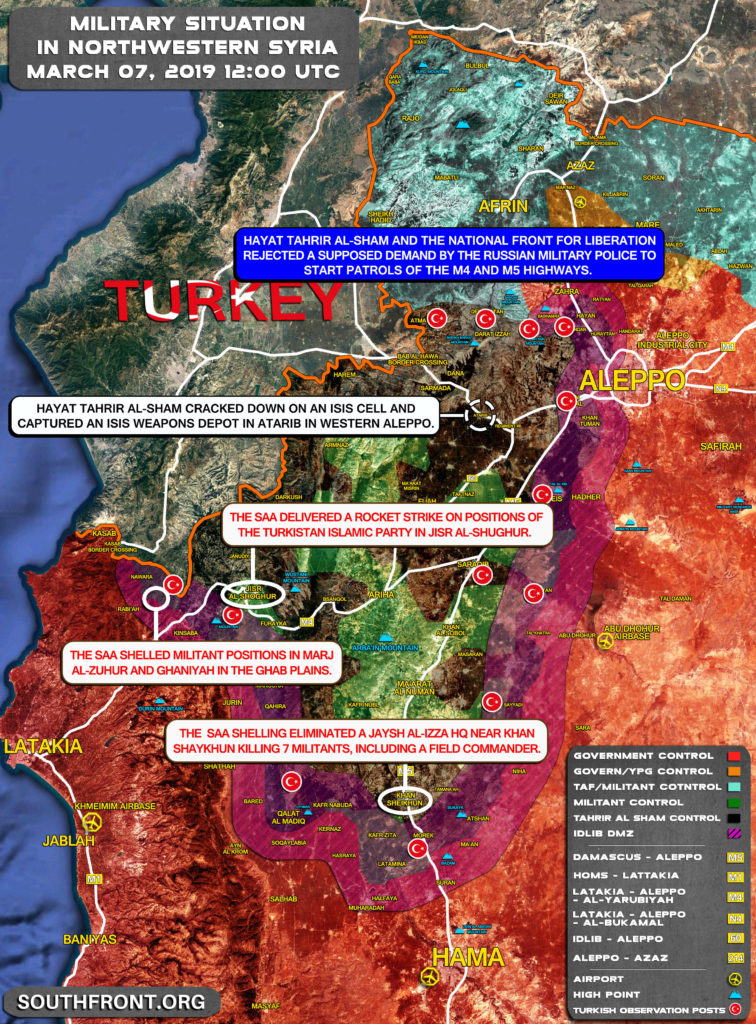On March 6, a Turkish military convoy consistng of a dozen of military vehicles and up to 100 service members entered the Idlib de-escalation zone, according to local sources. These personnel and equipment reportedly moved towards Turkish observation posts, which had been established in southern Idlib, southwestern Idlib and northern Hama.
Despite these observation posts, Idlib militant groups, first of all Hayat Tahrir al-Sham, Jaysh al-Izza and the Turkistan Islamic Party, continue to violate the ceasefire regime established in the area on a daily basis. This puts Ankara, which insists that the demiltiarized zone agreement is mostly observed, into an ambiguous position. On one had, Turkey claims that it works with Iran, Russia and the Damascus government against terrorists. On the other hand, it defends terrorists undermining de-escalation efforts in Idlib.
Meanwhile, reports appeared that Hayat Tahrir al-Sham and the Turkish-backed National Front for Liberation had jointly rejected an idea of Russian Military Police patrols in the areas of M4 and M5 highways. While there is nothing unexpected in this attitude, it puts an end to earlier speculations that Russian and Turkish forces may start joint patrols in the demilitarized zone area.
On February 16, Russia’s Foreign Minister Sergei Lavrov revealed that Ankara and Moscow had reached an agreement that they “would try to establish a step-by-step approach, making several areas of joint patrol inside the [Idlib] zone of de-escalation”. However, this would remain unrealistic until Hayat Tahrir al-Sham and its allies remain deployed in the demilitarized zone.
Efforts undertaken in the framework of the Astana negotiations format allowed to partially de-escalate the sitaution in the Idlib zone, but no real steps were taken to separate the Turkish-backed “moderate opposition” from “terrorists” in the area. The problem is that both these groups of rebels are mostly the same thing.
Ankara, Moscow and Tehran publicly declare their commitment to the combating of terrorism. Nonetheless, the situation is quite different on the ground. The Syrian-Russian-Iranian alliance exhausted all of their peaceful efforts to solve the militancy issue in the Idlib demilitarized zone and a military option remains the only realistic opportunity to undermine the terrorist influence in Idlib and to propel a peaceful process further.
A brief overview of the recent developments in northwestern Syria:
- The SAA delivered a rocket strike on positions of the Turkistan Islamic Party in Jisr al-Shughur;
- The SAA shelling eliminated a Jaysh al-Izza HQ near Khan Shaykhun killing 7 militants, including a field commander;
- Hay’at Tahrir al-Sham cracked down on an ISIS cell and captured an ISIS weapons depot in Atarib in western Aleppo;
- Hayat Tahrir al-Sham and the National Front for Liberation rejected a supposed demand by the Russian Military Police to start patrols of the M4 and M5 highways;
- The SAA shelled militant positions in Marj al-Zuhur and Ghaniyah in the Ghab plains.






